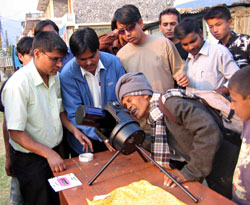|
|
| ECLIPSED IN POKHARA: Ram Bahadur Gurung, 83, peers at the solar eclispse on 29 March at the Galileo Astronomical Society of Pokhara. |
The seventh planet from the Sun is not normally considered a goal for stargazers because it's so dim. Nevertheless, it is a major body in our solar system and is on many people's to-see list. Binoculars will give you a good chance to find this planet despite it being two billion miles away. In the morning twilight of 18 April, Uranus will shine dimly just to the right of brilliant Venus.
Another don't-miss event is the Lyrids meteor shower at midnight on 22 April. Look towards the constellation of Lyra (Beena) which should be right overhead.
Comet hunters! Comet Schwassmann-Wachmann-3 may be visiting our celestial neighbourhood in May. That's a long shot-keep your fingers crossed.
Other highlights in April's sky:
The Moon\'s First Quarter is on 5 April, the Full Moon on 13 April and the Last Quarter on 21 April. The next New Moon will glow on 28 April.
Mercury is at its furthest west of the Sun on 8 April, when it is in a good position for viewing as it rises about an hour before sunrise. Afterwards, the planet appears to change direction and head towards the sun.
Venus is a brilliant \'morning star\', visible low in the east at dawn. It rises less than an hour before the Sun but it's so bright that it can be seen even in full daylight.
Mars, in Taurus, is only 40 degrees above the western horizon at sunset and sets at midnight. For those with telescopes, look for Mars near the open star cluster M35 in Gemini on 17 April. It is a tiny featureless disk in most telescopes by mid-month.
Jupiter rises in the eastern sky about 10.30 PM. But it comes up a little earlier each night and by the end of the month, it's rising at 8.30 PM. It looks like a very bright star, shining with a steady light.
Saturn is high in the western sky at dusk and sets in the west about 4AM. It's moving very slowly south-eastwards in Cancer, left of Gemini's \'twins\'. Saturn looks brighter than almost any other star, except for Sirius far below it, and shines with a steady, creamy-white light.
Uranus is in the centre of Aquarius but at the limit of visibility with the naked eye (6.0 magnitude). Neptune is in the centre of Capricornus but its low magnitude (8.0) makes it impossible to see without optical aid and detailed maps. Pluto is well beyond the sight of all but the best telescopes.
Meteors the Lyrids meteor shower begins around 19 April, reaches its peak on the 22nd and is over by the 25th. This is not a particularly good shower, averaging only 10 meteors per hour but anything can happen. The meteors seem to radiate outwards from a point in the constellation Lyra, close to the bright star Vega (Abhijit).
The Nepali New Year 2063 falls on 14 April at 7.52 AM. I wish you all clear skies and Happy New Year 2063.
[email protected]



